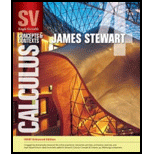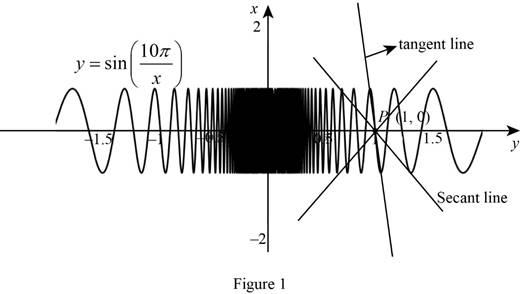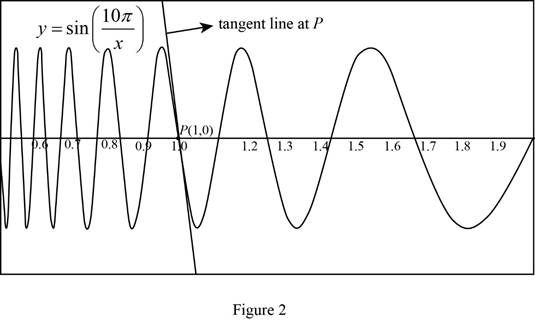
The point P(1, 0) lies on the curve y = sin(l0π/x).
(a) If Q is the point (x, sin(10π/x)), find the slope of the secant line PQ (correct to four decimal places) for x = 2, 1.5, 1.4, 1.3, 1.2, 1.1, 0.5. 0.6, 0.7, 0 .8, and 0.9.
Do the slopes appear to be approaching a limit?
(b) Use a graph of the curve to explain why the slopes of the secant lines in part (a) arc not close to the slope of the tangent line at P.
(c) By choosing appropriate secant lines, estimate the slope of the tangent line at P.
(a)
To find: The slope of the secant line PQ for the given values of x.
Answer to Problem 9E
The slope of the secant line PQ for the following values of x is given below:
| x | |
| 2 | 0 |
| 1.5 | 1.7321 |
| 1.4 | −1.0847 |
| 1.3 | −2.7433 |
| 1.2 | −4.3301 |
| 1.1 | −2.8173 |
| 0.5 | 0 |
| 0.6 | −2.1651 |
| 0.7 | −2.6061 |
| 0.8 | −5 |
| 0.9 | 3.4202 |
Explanation of Solution
Given:
The equation of the curve is
The point P(1, 0) lies on the curve y.
The Q is the point
Calculation:
The slope of the secant lines between the points, P(1, 0) and Q
Obtain the slope of the secant line PQ for the value of
Substitute 2 for x in
Substitute Q
Thus, the slope of the secant line PQ for the value of
Obtain the slope of the secant line PQ for the value of
Substitute 1.5 for x in
Substitute Q
Thus, the slope of the secant line PQ for the value of
Obtain the slope of the secant line PQ for the value of
Substitute 1.4 for x in
Substitute Q
Thus, the slope of the secant line PQ for the value of
Obtain the slope of the secant line PQ for the value of
Substitute 1.3 for x in
Substitute Q
Thus, the slope of the secant line PQ for the value of
Obtain the slope of the secant line PQ for the value of
Substitute 1.2 for x in
Substitute Q
Thus, the slope of the secant line PQ for the value of
Obtain the slope of the secant line PQ for the value of
Substitute 1.1 for x in
Substitute Q
Thus, the slope of the secant line PQ for the value of
Obtain the slope of the secant line PQ for the value of
Substitute 0.5 for x in
Substitute Q
Thus, the slope of the secant line PQ for the value of
Obtain the slope of the secant line PQ for the value of
Substitute 0.5 for x in
Substitute Q
Thus, the slope of the secant line PQ for the value of
Obtain the slope of the secant line PQ for the value of
Substitute 0.7 for x in
Substitute Q
Thus, the slope of the secant line PQ for the value of
Obtain the slope of the secant line PQ for the value of
Substitute 0.8 for x in
Substitute Q
Thus, the slope of the secant line PQ for the value of
Obtain the slope of the secant line PQ for the value of
Substitute 0.9 for x in
Substitute Q
Thus, the slope of the secant line PQ for the value of
Conclusion:
The slope does not appear to be approaching a limit. Suppose x approaches 1, then the slope
(b)
To explain: The slopes of the secant lines in part (a) are not close to the slope of the tangent line at P by using a graph.
Explanation of Solution
The graph of the curve

From Figure 1, it is observed that there seems to be the frequent oscillations of the graph. Moreover, the tangent line is so steep at the point P(1, 0). Thus, the slopes of the secant lines are not closer to the slope of the tangent line at P. Therefore, it is necessary to consider the values of x much closer to 1 for better accurate estimates of the slope.
(c)
To estimate: The slope of the tangent line to the curve at P(1, 0).
Answer to Problem 9E
The estimated value of the slope of the tangent line to the curve at P (1, 0) is −31.4.
Explanation of Solution
The graph of the curve

The secant line is close to the tangent line at P(1, 0) when
The value of the slope of the tangent line to the curve at
Obtain the slope of the secant line PQ for the value of
Substitute 1.001 for x in
Substitute Q
Thus, the slope of the secant line PQ for the value of
Obtain the slope of the secant line PQ for the value of
Substitute 0.999 for x in
Substitute Q
Thus, the slope of the secant line PQ for the value of
The slope of the secant line PQ for the value of
Take the average of two slopes of the secant lines,
Thus, the estimated value of the slope of the tangent line to the curve at P (1, 0) is −31.4.
Chapter 2 Solutions
Single Variable Calculus: Concepts and Contexts, Enhanced Edition
Additional Math Textbook Solutions
Glencoe Math Accelerated, Student Edition
Precalculus (6th Edition)
Calculus Early Transcendentals, Binder Ready Version
Precalculus Enhanced with Graphing Utilities (7th Edition)
Precalculus: Mathematics for Calculus - 6th Edition
Calculus & Its Applications (14th Edition)
 Calculus: Early TranscendentalsCalculusISBN:9781285741550Author:James StewartPublisher:Cengage Learning
Calculus: Early TranscendentalsCalculusISBN:9781285741550Author:James StewartPublisher:Cengage Learning Thomas' Calculus (14th Edition)CalculusISBN:9780134438986Author:Joel R. Hass, Christopher E. Heil, Maurice D. WeirPublisher:PEARSON
Thomas' Calculus (14th Edition)CalculusISBN:9780134438986Author:Joel R. Hass, Christopher E. Heil, Maurice D. WeirPublisher:PEARSON Calculus: Early Transcendentals (3rd Edition)CalculusISBN:9780134763644Author:William L. Briggs, Lyle Cochran, Bernard Gillett, Eric SchulzPublisher:PEARSON
Calculus: Early Transcendentals (3rd Edition)CalculusISBN:9780134763644Author:William L. Briggs, Lyle Cochran, Bernard Gillett, Eric SchulzPublisher:PEARSON Calculus: Early TranscendentalsCalculusISBN:9781319050740Author:Jon Rogawski, Colin Adams, Robert FranzosaPublisher:W. H. Freeman
Calculus: Early TranscendentalsCalculusISBN:9781319050740Author:Jon Rogawski, Colin Adams, Robert FranzosaPublisher:W. H. Freeman
 Calculus: Early Transcendental FunctionsCalculusISBN:9781337552516Author:Ron Larson, Bruce H. EdwardsPublisher:Cengage Learning
Calculus: Early Transcendental FunctionsCalculusISBN:9781337552516Author:Ron Larson, Bruce H. EdwardsPublisher:Cengage Learning





